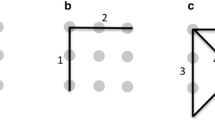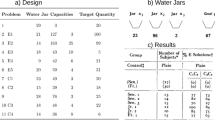Abstract
The nine-dot problem is often used to demonstrate and explain mental impasse, creativity, and out of the box thinking. The present study investigated the interplay of a restricted initial search space, the likelihood of invoking a representational change, and the subsequent constraining of an unrestricted search space. In three experimental conditions, participants worked on different versions of the nine-dot problem that hinted at removing particular sources of difficulty from the standard problem. The hints were incremental such that the first suggested a possible route for a solution attempt; the second additionally indicated the dot at which lines meet on the solution path; and the final condition also provided non-dot locations that appear in the solution path. The results showed that in the experimental conditions, representational change is encountered more quickly and problems are solved more often than for the control group. We propose a cognitive model that focuses on general problem-solving heuristics and representational change to explain problem difficulty.





Similar content being viewed by others
Notes
It does not follow that reaching impasse on a problem automatically produces a representational change (i.e. insight), since this is not always the case (Jones, 2003). Equally, whether insight is achieved and if so how quickly it is achieved depends on multiple factors, such as the difficulty of a change to the problem representation and how large the problem space is (Knoblich et al., 1999; Kershaw et al., 2013).
This point was raised by an anonymous reviewer.
References
Ash, I. K., & Wiley, J. (2006). The nature of restructuring in insight: an individual-differences approach. Psychonomic Bulletin & Review, 13, 66–73.
Burnham, C., & Davis, K. (1969). The nine-dot problem: beyond perceptual organization. Psychonomic Science, 17, 321–323.
Chronicle, E. P., Ormerod, T. C., & MacGregor, J. N. (2001). When insight just won’t come: the failure of visual cues in the nine-dot problem. The Quarterly Journal of Experimental Psychology, 54A, 903–919.
Duncker, K. (1945). On Problem-Solving (Vol. 58). Washington: American Psychological Association Inc.
Grant, E. R., & Spivey, M. J. (2003). Eye movements and problem solving: guiding attention guides thought. Psychological Science, 14, 462–466.
Hosmer, D. W., & Lemeshow, S. (2000). Applied logistic regression. New York: Wiley-Interscience.
Jones, G. (2003). Testing two cognitive theories of insight. Journal of Experimental Psychology. Learning, Memory, and Cognition, 29, 1017–1027.
Kaplan, C. A., & Simon, H. A. (1990). In search of insight. Cognitive Psychology, 22, 374–419.
Kershaw, T. C., Flynn, C. K., & Gordon, L. T. (2013). Multiple paths to transfer and constraint relaxation in insight problem solving. Thinking & Reasoning, 19, 96–136.
Kershaw, T. C., & Ohlsson, S. (2004). Multiple causes of difficulty in insight: the case of the nine-dot problem. Journal of Experimental Psychology. Learning, Memory, and Cognition, 30, 3–13.
Knoblich, G., Ohlsson, S., Haider, H., & Rhenius, D. (1999). Constraint relaxation and chunk decomposition in insight problem solving. Journal of Experimental Psychology. Learning, Memory, and Cognition, 25, 1534–1555.
Litchfield, D., & Ball, L. J. (2011). Using another’s gaze as an explicit aid to insight problem solving. The Quarterly Journal of Experimental Psychology, 64, 649–656.
Lung, C.-T., & Dominowski, R. L. (1985). Effects of strategy instructions and practice on nine-dot problem solving. Journal of Experimental Psychology. Learning, Memory, and Cognition, 11, 804–811.
MacGregor, J. N., Ormerod, T. C., & Chronicle, E. P. (2001). Information processing and insight: a process model of performance on the nine-dot and related problems. Journal of Experimental Psychology. Learning, Memory, and Cognition, 27, 176–201.
Maier, N. R. F. (1930). Reasoning in humans. I On direction. Journal of Comparative Psychology, 10, 115–143.
Newell, A., & Simon, H. A. (1972). Human problem solving. Englewood Cliffs, NJ: Prentice Hall.
Ohlsson, S. (1984a). Restructuring revisited: I. Summary and critique of the Gestalt theory of problem solving. Scandinavian Journal of Psychology, 25, 65–78.
Ohlsson, S. (1984b). Restructuring revisited: II. An information processing theory of restructuring and insight. Scandinavian Journal of Psychology, 25, 117–129.
Ohlsson, S. (1992). Information-processing explanations of insight and related phenomena. In M. Keane & K. Gilhooly (Eds.), Advances in the Psychology of Thinking (pp. 1–44). London: Harvester-Wheatsheaf.
Öllinger, M., Jones, G., Faber, A. H., & Knoblich, G. (2012). Cognitive mechanisms of insight: the role of heuristics and representational change in solving the eight-coin problem. Journal of Experimental Psychology: Learning, Memory, and Cognition, 39(3), 931–939.
Öllinger, M., Jones, G., & Knoblich, G. (2008). Investigating the Effect of Mental Set on Insight Problem Solving. Experimental Psychology, 55, 269–282.
Ormerod, T. C., Chronicle, E. P., & MacGregor, J. N. (1997). Facilitation in variants of the nine-dot problem: perceptual or cognitive mediation? Poster presented at the 18th Annual Conference of the Cognitive Science Society. Stanford: CA.
Ormerod, T. C., MacGregor, J. N., & Chronicle, E. P. (2002). Dynamics and constraints in insight problem solving. Journal of Experimental Psychology. Learning, Memory, and Cognition, 28, 791–799.
Scheerer, M. (1963). Problem-Solving. Scientific American, 208, 118–128.
Thevenot, C., & Oakhill, J. (2008). A generalization of the representational change theory from insight to non-insight problems: the case of arithmetic word problems. Acta Psychologica, 129, 315–324.
Thomas, L. E., & Lleras, A. (2007). Moving eyes and moving thought: on the spatial compatibility between eye movements and cognition. Psychonomic Bulletin & Review, 14, 663–668.
Weisberg, R. W., & Alba, J. W. (1981). An examination of the alleged role of “fixation” in the solution of several “insight” problems. Journal of Experimental Psychology: General, 110, 169–192.
Acknowledgments
This research was made possible by a grant from the German Research Foundation (DFG) KN-489/6–2.
Author information
Authors and Affiliations
Corresponding author
Rights and permissions
About this article
Cite this article
Öllinger, M., Jones, G. & Knoblich, G. The dynamics of search, impasse, and representational change provide a coherent explanation of difficulty in the nine-dot problem. Psychological Research 78, 266–275 (2014). https://doi.org/10.1007/s00426-013-0494-8
Received:
Accepted:
Published:
Issue Date:
DOI: https://doi.org/10.1007/s00426-013-0494-8




